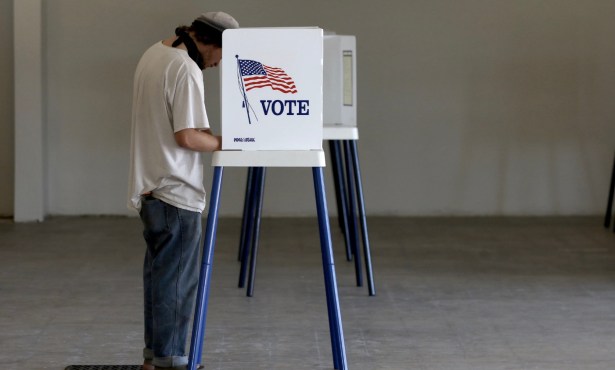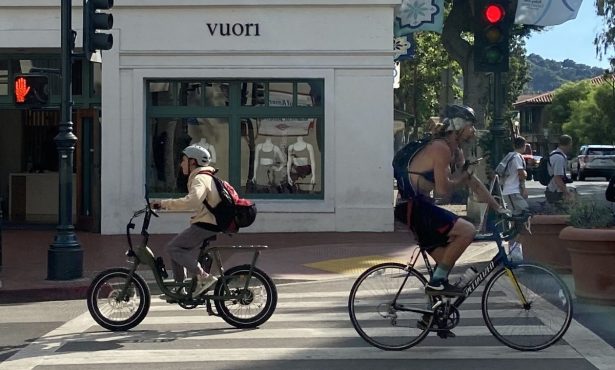You Damn Dirty Dogs!
Bicycles Über Alles and Why It's OK for Me to Blow Stop Signs
GOING ROUND AND ROUND: I hate to say it, but yes, I am that guy. By that, I mean the guy on the bike who blows through stop signs with considerable regularity. At this Tuesday’s City Council meeting, one councilmember objected that such scofflaw behavior was occurring “willy-nilly.” Early this morning, I must have been feeling pretty willy-nilly because I didn’t think twice as I rolled through the intersection half a block from the office. Nor did I look once at the car behind me, which, it turned out, happened to be a police car. Like I say, it was early. Dawn had not cracked. As a result, I couldn’t see if the officer was shaking his head or not. He could easily have hit me with a $500 ticket. Whoever you are, I owe you one.

Admittedly, there are some sanctimonious bike riders looking to justify any assault on common courtesy, citing — ad nauseam — their second-class status on the road. For the record, that ain’t me. In defense of my selective compliance with the law, I would point out that the great state of Idaho — typically regarded as a backwater of retrograde thinking — legally allows bicyclists to run stop signs, though not stoplights. This law recognizes the physical exertion associated with a bicyclist stopping then starting is far more problematic for motorists. Idaho, in writing this law, put the onus on the cyclist to look both ways first. Cyclists who get hit have no one but themselves to blame. Based on the accident stats, this approach seems to work. Maybe this law plays some role in the surprising fact that Boise, Idaho — where it gets really cold and it really snows — has been deemed a far more bike-friendly town by the League of American Bicyclists than Santa Barbara. By all rights, one would think Santa Barbara should be Number One. Aside from three days a year, it’s always sunny here. It’s rarely too hot and almost never too cold. Much of the terrain is flat. And those residents not fixated on their health are obsessed with their appearances. So what gives?
This Tuesday, the City Council spent a fair amount of time mulling whether this should be defined as a conundrum, a dilemma, a question, or an opportunity. I’m not sure how they resolved this semantic riddle, but they did vote to spend $200,000 on serious public outreach as part of an effort to draft a new bicycle master plan. As someone who believes that approximately 98.6 percent of all social ills could be ameliorated if more people just rode bikes — it ain’t just good for you; it’s fun — I was of course thrilled. The last such master plan was written in 1998 as a feel-good gesture for cyclists, seen as a special interest. It accomplished a lot. We now have 40 miles of bike lanes as opposed to 13. In 2000, 3.4 percent of all workers in the city commuted by bike; by 2012 it was 6.9 percent. That’s huge. Santa Barbara ranks third in the nation for comparably sized cities when it comes to bicycle commuting, and for any sized city, it ranks eighth. These numbers demonstrate that even if you don’t build it — “it” being more advanced bicycle-friendly infrastructure — they will still come. The consequence, of course, is safety problems. Santa Barbara has an unacceptably high rate of car-on-bike collisions. In the past three years, 400 were sufficiently serious that cops were called to the scene.
Those accident stats demonstrate that cycling is no longer an optional amenity to better accommodate the Dockers-clad young urban professional on his way to work or the Spandex exhibitionist lucky enough not to have to work. The bike is utilitarian in the extreme. For a whole lot of people for a whole lot of reasons — the price of gas, parking, repairs, and insurance, to name just a few — the bike has become a necessity. That the bike offers such an obvious way people can respond to climate change is almost icing on the cake. It’s no longer about City Hall deigning to do cyclists any favors; it’s just common sense. When there are fewer cars on the road, motorists benefit. Studies suggest significant congestion reductions can be achieved when only a relatively few drivers are induced to hop on their bikes. What’s most persuasive is safety. Bike-friendly work environments are nice; bike lanes are crucial. In cities where real separation between cyclists and car has been achieved — by planters, Botts’ Dots, or bollards — bike use increased between 21 and 171 percent. Sometimes, however, a little paint on the road works wonders. Look at the new bike lane on Haley Street. It’s been a huge success without impinging on the flow of traffic. Likewise, the road diet and restriping on Cliff Drive and upper Chapala Street. Despite all the dire predictions the sky would fall when the separated bike lane between Leadbetter Beach and Shoreline Park was installed several years ago, that project has proved remarkably trouble-free. Admittedly, many of the quick-n-easy fixes have already been made. The next ones will undoubtedly cannibalize some on-street parking. That’s always hard. But didn’t someone famous say, “You can’t make an omelet without breaking a few parking spaces?”
The timing of the city’s master plan couldn’t be better. That’s because the federal Highway Trust Fund, the Social Security system for road repair and infrastructure funding, is verging on the precipice of financial collapse. Congress just voted to steal $10 billion from the underground storage tank cleanup fund — for leaking gas tanks that imperil groundwater supplies — but that’ll buy only a few extra months. More immediately, the city’s planning process will dovetail nicely with similar efforts taking place at the same time by the County of Santa Barbara and the cities of Carpinteria and Goleta. How synchronicitous.
In the meantime, I’ll try to not be so “willy-nilly” when it comes to blowing stop signs. At least when the cops are right behind me.



